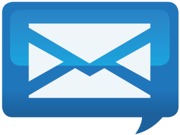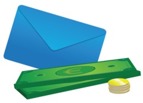|
 Sending Newsletters via E-mail (21 Advantages) The
sending of newsletters via e-mail has many benefits and areas of use.
Newsletters are an effective way of providing information to customers,
consumers, association or club members and employees. They can also be
used to market and sell products and services. Regardless of the purpose
for which they are used, the sending of newsletters can help you to
realise many advantages. And it is not particularly difficult to produce
and send electronic newsletters as long as you have the right software and
knowledge about how to proceed. The
sending of newsletters via e-mail has many benefits and areas of use.
Newsletters are an effective way of providing information to customers,
consumers, association or club members and employees. They can also be
used to market and sell products and services. Regardless of the purpose
for which they are used, the sending of newsletters can help you to
realise many advantages. And it is not particularly difficult to produce
and send electronic newsletters as long as you have the right software and
knowledge about how to proceed. Below we discuss some of the most significant advantages associated with creating and sending newsletters via e-mail. We hope that this information will inspire those who do not currently have a newsletter to start one, while existing users of newsletters may identify new areas of use. 1. A newsletter can be personalised It is easy to customise the contents of a newsletter to suit each individual customer; something that is not possible with items such as advertising notices and which is difficult to achieve with printed materials. By personalising your newsletter you can make it more interesting and relevant for your customers. In this way you can easily combine general and specialised items of news that are of relevance to selected groups of recipients on your e-mailing list. 2. Sending newsletters is fast It takes very little time to produce and send out a newsletter to a selected customer group, making e-mail the ideal method for reaching your customers with the latest news. With a good e-mail program you are able to send out thousands of newsletters per hour - with news that is customised to suit each individual e-mail recipient. There is no other method for communicating with your customers that is as fast and cost-effective. 3. Newsletters increase the number of visitors to your website A newsletter with interesting content will increase the number of visitors to your website. It allows you to present information that is so interesting that your subscribers become curious and want to know more. By adding a link at the end of each article you will enable the readers to proceed directly to the appropriate location on your website where you can provide more detailed information. 4. Newsletters are ranked highly by search engines By publishing your newsletters on your website they will become more interesting for Internet search engines (Google, Yahoo, Bing etc). Furthermore, because the contents of your newsletters are related to the other information on your website, the individual pages on your site will also receive high rankings. A good newsletter should contain the most important information about your company and your products, which is why it is vital that you try to include the keywords that your customers can be expected to use when conducting searches via Internet search engines. 5. The search engine ranking of your webpages will improve as a result Another reason for publishing your newsletter on your website is that you will improve the search engine ranking of your other webpages. By creating links from your newsletter to other pages on your website you will improve the ranking of these other pages i.e. they will be presented higher up among the results of Internet searches. 6. You determine the content Because it is possible to quickly change the contents of a newsletter you can ensure that your newsletter always contains the very latest news and happenings. Unlike adverts and brochures, newsletters do not force you to decide on the final content a long time in advance, and you are able to quickly change the contents right up to the point of publication without incurring any significant additional costs. Current and updated content makes your newsletters more relevant for your subscribers. 7. You determine the publication interval and publication dates  It
is entirely up to you when and how often you wish to issue your
newsletter. You do not have to worry about any stressful deadlines as is
the case with activities such as advertising. Instead, you can simply
send out your newsletter when you have sufficient interesting
information that you feel your customers would like to know about. It
is, however, a good idea to try to send out your newsletters as
regularly as possible. It
is entirely up to you when and how often you wish to issue your
newsletter. You do not have to worry about any stressful deadlines as is
the case with activities such as advertising. Instead, you can simply
send out your newsletter when you have sufficient interesting
information that you feel your customers would like to know about. It
is, however, a good idea to try to send out your newsletters as
regularly as possible.8. Regular newsletters enhance the profile of your products and your company By sending newsletters regularly you remind your customers about your company and the products and services that you offer. This makes your customers more aware of your company and increases the likelihood that they will contact you when they require such products or services. Regular contact also shows your customers that your company is stable and that it works in a long-term manner, which in turn will increase the customers' confidence in you and your company. 9. Ability to measure what is of interest to your subscribers/customers By frequently sending out regular newsletters and by publishing short articles you are able to find out what your subscribers/customers are particularly interested in. You can do this indirectly via statistics, for example by measuring which newsletters are read the most and which links the readers click on. By encouraging readers to react to various types of content you can also obtain direct feedback about the things that interest them the most. You can then use this information for other e-mailings. 10. Your customers gain more confidence in you Your customers will gain more confidence in you if you share and exhibit your expertise. By sending out a newsletter with well written and educative articles you show your customers that you have a high level of expertise within your field, which provides assurance that the products and services supplied by your company will also be of high quality. 11. Free marketing If you have a good and interesting newsletter your subscribers can help you market your company and your products for free. Even if they themselves don't require your products and services at a particular point in time, your subscribers may have colleagues or customers that do, in which case they can simply forward your e-mail to the interested parties. Feel free to include a message that the subscribers are welcome to forward the newsletter to others as they so wish. Apart from the fact that this method of marketing is free (your subscriber does the "work"), the recipient of the forwarded newsletter is also likely to place a high degree of trust in its content since it has come on the recommendation of an acquaintance or colleague. Many feel that this is the best way of obtaining new e-mail addresses for one's e-mailing list. 12. Sending newsletters via e-mail is cheap Sending newsletters via e-mail is a cheap way of communicating with your customers. If you make a comparison with other methods such as normal mailings, telephone, fax, newspaper advertising, radio/TV advertising etc. you will see that the costs involved with sending out a newsletter via e-mail are negligible. 13. You determine the costs involved Because the cost of actually sending an e-mailing is minimal it is the production of the newsletter itself that represents the biggest expense. You have total control over how much time and money you wish to invest in your newsletter. If you don't have much time or if you wish to save money you can simply produce a more basic version to begin with, or alternatively use an existing newsletter as a template so that you only need to change the text but can retain the fundamental design. However, it could be more profitable in the long run to allow a designer to create the first newsletter, which you can then use as your template. There are also e-mail programs available that provide ready-made templates upon which you can build. 14. Always available online The Internet ensures your newsletter is available to your customers even if they are away travelling. These days there are a number of methods they can use in order to read your newsletters. They can either read them with the help of a mobile phone and a laptop/palmtop computer, or they can visit their e-mail operator's website and use webmail to read them there. Newer types of mobile phone also have built-in e-mail clients that make it possible to receive e-mail directly to the mobile phone. Furthermore, if you have a copy of your newsletter available on your website it is possible to read it with the help of a web browser. 15. Your customers can choose where and when to read your newsletter  Your
customers can choose where and when they want to read your newsletter.
Thanks to this possibility they can read your newsletter in peace and
quiet when they have time, without feeling any stress. This means that
they can more easily absorb and analyse the information, regardless of
whether you have provided a short newsletter with links to more detailed
information on your website, or a long newsletter containing a lot of
information itself i.e. long articles. Your
customers can choose where and when they want to read your newsletter.
Thanks to this possibility they can read your newsletter in peace and
quiet when they have time, without feeling any stress. This means that
they can more easily absorb and analyse the information, regardless of
whether you have provided a short newsletter with links to more detailed
information on your website, or a long newsletter containing a lot of
information itself i.e. long articles.16. Newsletters are perfect for e-mail marketing Using a newsletter as part of your e-mail marketing gives you the possibility to market your products and services in a very flexible manner. You can include articles that describe various uses for your products. You can also use practical examples to demonstrate why it is beneficial for your customers to make use of your services. In addition, it is also possible to include advertisements for your products and services in your newsletter, ideally with some direct association to the article texts. However, be careful not to include too many adverts because there is a risk that the readers will then grow wary and will stop reading the newsletter. Many people feel that a newsletter represents the most effective method of e-mail marketing available because it is long-term in nature and cost-effective. 17. Sales of your products and services will increase It is never wrong to include an attractive special offer in your newsletter. Ideally, such an offer should be unique and only available to those that subscribe to your newsletter. In this way you have a chance to sell your products and services while also making your customers feel special. However, the special offer should not dominate the newsletter, but should be included as a bonus for the reader. 18. Earn money  If
you have a newsletter with a relatively large circulation, other
companies may be interested in advertising in your newsletter. This
gives you the opportunity to sell ad spots and thus earn money. However,
try to find advertisers that offer products and services that complement
your own products and services, and that are associated with the
articles in the newsletter. People will not read adverts that do not
feel relevant to them, which is why the adverts that you include in your
newsletter must be suitable for your target audience. If
you have a newsletter with a relatively large circulation, other
companies may be interested in advertising in your newsletter. This
gives you the opportunity to sell ad spots and thus earn money. However,
try to find advertisers that offer products and services that complement
your own products and services, and that are associated with the
articles in the newsletter. People will not read adverts that do not
feel relevant to them, which is why the adverts that you include in your
newsletter must be suitable for your target audience. 19. E-mails do not take up space unnecessarily As opposed to all printed information and materials that your customers receive, e-mails do not take up unnecessary amounts of space on their desks or in their bookshelves. This also means that you can send a number of different newsletters to your customers without running the risk that your e-mails will be discarded as can often be the case with mailings via regular post. 20. Newsletters are easy to file away If you provide newsletters with content that is very important to your subscribers they will be inclined to save them and file them away for later use. You can achieve this by including exclusive information or comprehensive educational information that your customers feel will be useful to them in the future. 21. You can design and distribute your newsletters You don't need to be some sort of advertising guru or computer expert in order to create and send out personalised newsletters via e-mail. As long as you have the right tools and knowledge you can quickly and easily produce newsletters that your customers will appreciate. You know best what your customers are interested in, so you can begin by creating simple newsletters that contain valuable information for your customers. As time goes by you can increase the rate at which you publish your newsletters, produce more and new types of newsletter and improve the design and the quality of the contents.
Related products: SamLogic MultiMailer Other articles More articles are available from the article index page. |
|
| Article written by: Anders Persson | Spanish Swedish |








